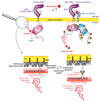Brassinosteroid signaling and BRI1 dynamics went underground
- PMID: 27419885
- PMCID: PMC5055102
- DOI: 10.1016/j.pbi.2016.06.014
Brassinosteroid signaling and BRI1 dynamics went underground
Abstract
Brassinosteroids (BRs) are a group of steroid molecules perceived at the cell surface and that act as plant hormones. Since their discovery as crucial growth substances, BRs were mainly studied for their action in above ground organs and the BR signaling pathway was largely uncovered in the context of hypocotyl elongation. However, for the past two years, most of the exciting findings on BR signaling have been made using roots as a model. The Arabidopsis root is a system of choice for cell biology and allowed detailed characterization of BR perception at the cell membrane. In addition, a series of elegant articles dissected how BRs act in tissue specific manners to control root growth and development.
Copyright © 2016 Elsevier Ltd. All rights reserved.
Figures




Similar articles
-
Transcription factor HAT1 is phosphorylated by BIN2 kinase and mediates brassinosteroid repressed gene expression in Arabidopsis.Plant J. 2014 Jan;77(1):59-70. doi: 10.1111/tpj.12368. Epub 2013 Dec 3. Plant J. 2014. PMID: 24164091
-
Turning on the microscope turret: a new view for the study of brassinosteroid signaling in plant development.Physiol Plant. 2014 Jun;151(2):172-83. doi: 10.1111/ppl.12130. Epub 2014 Feb 19. Physiol Plant. 2014. PMID: 24547704 Review.
-
A mathematical model for the coreceptors SOMATIC EMBRYOGENESIS RECEPTOR-LIKE KINASE1 and SOMATIC EMBRYOGENESIS RECEPTOR-LIKE KINASE3 in BRASSINOSTEROID INSENSITIVE1-mediated signaling.Plant Physiol. 2013 Nov;163(3):1472-81. doi: 10.1104/pp.113.222034. Epub 2013 Sep 26. Plant Physiol. 2013. PMID: 24072582 Free PMC article.
-
Brassinosteroid signaling in plant development and adaptation to stress.Development. 2019 Mar 14;146(5):dev151894. doi: 10.1242/dev.151894. Development. 2019. PMID: 30872266 Free PMC article. Review.
-
BSKs are partially redundant positive regulators of brassinosteroid signaling in Arabidopsis.Plant J. 2013 Jun;74(6):905-19. doi: 10.1111/tpj.12175. Epub 2013 Apr 15. Plant J. 2013. PMID: 23496207
Cited by
-
Membrane estrogen receptor 1 is required for normal reproduction in male and female mice.J Endocrinol Reprod. 2017 Jun;21(1):1-14. J Endocrinol Reprod. 2017. PMID: 34321782 Free PMC article.
-
Auxin-Regulated Reversible Inhibition of TMK1 Signaling by MAKR2 Modulates the Dynamics of Root Gravitropism.Curr Biol. 2021 Jan 11;31(1):228-237.e10. doi: 10.1016/j.cub.2020.10.011. Epub 2020 Nov 5. Curr Biol. 2021. PMID: 33157019 Free PMC article.
-
Arabidopsis protein S-acyl transferases positively mediate BR signaling through S-acylation of BSK1.Proc Natl Acad Sci U S A. 2024 Feb 13;121(7):e2322375121. doi: 10.1073/pnas.2322375121. Epub 2024 Feb 5. Proc Natl Acad Sci U S A. 2024. PMID: 38315835 Free PMC article.
-
Local brassinosteroid biosynthesis enables optimal root growth.Nat Plants. 2021 May;7(5):619-632. doi: 10.1038/s41477-021-00917-x. Epub 2021 May 17. Nat Plants. 2021. PMID: 34007032
-
Brassinosteroids: Multidimensional Regulators of Plant Growth, Development, and Stress Responses.Plant Cell. 2020 Feb;32(2):295-318. doi: 10.1105/tpc.19.00335. Epub 2019 Nov 27. Plant Cell. 2020. PMID: 31776234 Free PMC article. Review.
References
Publication types
MeSH terms
Substances
Grants and funding
LinkOut - more resources
Full Text Sources
Other Literature Sources
Miscellaneous

